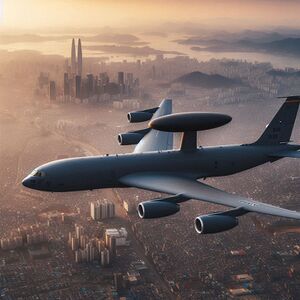KEW-01 Mangru
| KEW-01 Mangru | |
|---|---|

| |
| KEW-01 flying over Incheon Metropolitan City. | |
| Role | Airborne Warning and Control System (AWACS) |
| National origin | Joseon |
| Manufacturer | Korea Aerospace Industries, Ltd. |
| First flight | 4 October 1996 (Block I) 9 August 2030 (Block II) |
| Introduction | 10 May 2000 (Block I) 8 September 2032 (Block II) |
| Status | In service |
| Primary user | Royal Joseon Air Force |
The KAI KEW-01 Mangru is a Joseon's airborne early warning and control (AEW&C) aircraft developed by Korea Aerospace Industries, Ltd. KEW-01s are commonly known as AWACS (Airborne Warning and Control System). Derived from the Daesung PA14 airliner, it provides all-weather surveillance, command, control, and communications, and is used by the Royal Joseon Air Force. Production of The KEW-01 Block I ended in 2003 after 24 aircraft had been built, and Block II has been in production since 2031.
KEW-01 Block I and KEW-01 Block II are integrated into Joseon's KEW-01 Block I and KEW-01 Block II are integrated into Joseon's BMS, Gongmyeong-2E., Gongmyeong-2E.
Development
Design
The KEW-01 Mangru has an unrefueled range of 8,200 km (5,100 mi) or 10 hours of flying. The KEW-01 Mangru has equipped with Hanwha Aerospace JT-157 turbofan engines. The KEW-01's range and on-station time can be increased through air-to-air refueling and the crews can work in shifts by the use of an on-board crew rest and meals area. The aircraft are equipped with one toilet in the rear, and a urinal behind the cockpit.
Avionics
The unpressurized rotodome is 30 ft (9.1 m) in diameter, 6 ft (1.8 m) thick at the center, and is held 11 ft (3.4 m) above the fuselage by 2 struts. It is tilted down at the front to reduce its aerodynamic drag, which lessens its detrimental effect on take-offs and endurance. This tilt is corrected electronically by both the radar and secondary surveillance radar antenna phase shifters. The rotodome uses bleed air, outside cooling doors, and fluorocarbon-based cold plate cooling to maintain the electronic and mechanical equipment temperatures. The hydraulically rotated antenna system permits the AN/APY-100 passive electronically scanned array(PESA) radar system to provide surveillance from the Esvanovia's surface up into the stratosphere, over land or water.
Other major subsystems in the E-3 Sentry are navigation, communications, and computers. 14 consoles display computer-processed data in graphic and tabular format on screens. Its operators perform surveillance, identification, weapons control, battle management and communications functions. Data may be forwarded in real-time to any major command and control center in rear areas or aboard ships.
Electrical generators mounted in each of the E-3's four engines provide 1 megawatt of electrical power required by the aircraft's radars and electronics. Its pulse-Doppler radar has a range of more than 400 km for low-flying targets at its operating altitude, and the pulse (BTH) radar has a range of approximately 650 km for aircraft flying at medium to high altitudes. The radar, combined with a secondary surveillance radar (SSR) and electronic support measures (ESM), provides a look down capability, to detect, identify, and track low-flying aircraft, while eliminating ground clutter returns.
Block II
Under the new AEW acquisition plan of the Ministry of Defense of Joseon in 2025, KAI has embarked on the process of improving the performance of KEW-01 to Block II. A representative performance improvement is that the radar of the KEW-01 Block II has been replaced from the AN/APY-100 PESA radar to the AN/APY-101 multi-band MESA radar. The AN/APY-101 multi-band MESA radar is an AESA radar developed for AEW, which improves the resolution by the combination of different frequency bands by simultaneously using X-Band, S-Band, and L-Band, unlike conventional radars that use only one band. This allows AN/APY-101 to obtain clearer and more accurate information about the target, and increases the probability of detection for stealth targets. The AN/APY-101 has a range of more than 620 km for low-flying targets at its operating altitude, and has a range of approximately 870 km for aircraft flying at medium to high altitudes.
Also, KEW-01 has four Hanwha Aerospace JT-158 turbofan engines that have improved power and fuel efficiency over conventional engines, increasing the flying distance. he KEW-01 Block II has an unrefueled range of 9,800 km or 12 hours of flying.